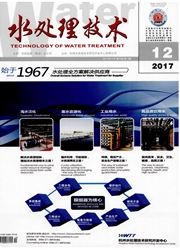

 中文摘要:
中文摘要:
以苯胺废水处理站剩余污泥为菌源,经富集、扩大培养获得高含量的硝化菌菌液,并以自行研制的纤维颗粒为载体进行了挂膜试验,考察了pH、溶解氧(DO)和无机碳源等主要工艺条件对苯胺降解硝化过程的影响。结果显示,在15d内微生物开始在载体表面形成生物膜,30d后膜厚稳定在120~150μm。条件试验结果表明,pH为8.5时硝化效果最佳,氨氧化速率达到43.22mg/L·d;DO为3.0mg/L时满足苯胺降解菌及硝化菌代谢需要;添加无机碳源可有效促进硝化反应的进行,当NaHCO3添加量为300mg/L,可使硝化速率提高30.68%。由此证明了在三相生物流化床中通过条件优化可消除苯胺废水降解过程释放的富余氨氮。
 英文摘要:
英文摘要:
High-active nitrobacteria was domesticated and isolated from excess sludge in a treatment plant for aniline wastewater. The nitrobacteria was further domesticated and fixed on surface with prepared fibre-granula as carrier in a three phase fluidized bed reactor. Subsequently, key operating conditions including pH, dissolved oxygen (DO) and adding of inorganic carbon source were used to investigating nitrification process during the degradation of aniline. The results showed that microorganism began to form biofilm on the surface of the carrier in 15d and after 30d, the biofilm had thickness 120-1500,m; when pH was 8.5, the nitrification effect was the best, ammonia oxidation rate reached to 43.22mg/L·d; DO 3.0mg/L could meet the needs for metabolism of aniline degradation bacteria and nitrobacteria; adding inorganic carbon source could promote nitrification reaction; adding 300mg/L NaHCO3 enabled nitrification rate rising by 30.68%,thus proving the residual ammonia nitrogen released in the course of aniline wastewater degradation could be removed in three-phase biological fluidized bed through optimization of operational conditions.
 同期刊论文项目
同期刊论文项目
 同项目期刊论文
同项目期刊论文
 期刊信息
期刊信息
